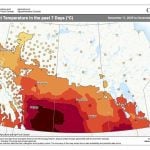As we have seen with the last few forecasts, the weather models have been doing a good job with the overall weather pattern but are struggling with the details. Take last issue’s forecast: the overall pattern looked mild and dry, and that is exactly what we saw. But the timing of the smaller-scale features was off, such as when the warmest day occurred or the exact track of the systems.
For this forecast period, it looks like the warm weather bubble is going to burst. Well, maybe ‘burst’ is the wrong word, as it implies a radical change that I don’t think we will see, but it is going to cool down. It looks like arctic high pressure will begin to drop southward behind the area of low pressure that tracked across the Prairies earlier in the week.
[RELATED] Getting a sense of snowfall probabilities
Read Also

Farmer gift idea: How about a weather station?
The 2025 holiday season is looming, and a home weather station might make a great Christmas gift for farmers
The main area of high pressure looks as if it will track southward through Alberta. This will help kick out an area of low pressure from the U.S. southwest. It looks like this low will come out in pieces, with the first piece bringing a chance of light snow to our region on Thursday or Friday. The second low will move northeast over the weekend, but indications are that it will stay well to our east thanks to the arctic high to our west.
The western area of high pressure will slide eastward behind this second low over the weekend, bringing sunny but cold conditions. Expect daytime highs to be in the -14 C range, with overnight lows falling into the -20 to -25 C range.
After the weekend, confidence again drops, as the weather models lack consistency. There is a hint of warmer air quickly moving back in as a large area of low pressure begins to come ashore in B.C. The counter-clockwise flow around this low should push out the arctic air, allowing temperatures to rebound. Daytime highs could warm back toward the -5 C range under this strong southwesterly flow.
The big question is, what happens to the Pacific low when it finally decides to move eastward? Currently, the models show the energy moving across northern Canada. If this does play out, expect mild and mostly dry weather for the first half of December.
Usual temperature range for this period: highs, -12 to 0 C; lows, -23 to -9 C
















